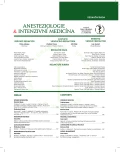The heart as a source of systemic embolization
Authors:
J. Rulíšek 1; Z. Hlubocká 2
Authors‘ workplace:
Klinika anesteziologie, resuscitace a intenzivní medicíny, Všeobecná fakultní nemocnice v Praze, 1. lékařská fakulta Univerzity Karlovy
1; Interní klinika, Všeobecná fakultní nemocnice v Praze, 1. lékařská fakulta Univerzity Karlovy
2
Published in:
Anest. intenziv. Med., 28, 2017, č. 6, s. 357-362
Category:
Overview
Embolism from the heart and the thoracic aorta often lead to significant mortality and morbidity. It is estimated that one third of all ischemic strokes are related to heart embolism. A typical reason for thrombus formation is the dilatation of a heart chamber, either atrial due to atrial fibrillation or flutter, or ventricular due to ischemic or non-ischaemic cardiomyopathy. Other sources are infective and non-infective endocarditis, cardiac tumors (myxoma is dominant) and ulcerated aortic atherosclerotic plaques. Echocardiography is the first line method in the diagnosis and management. Transthoracic and transoesophageal echocardiography as well as computed tomography and magnetic resonance are complementary methods. The article reviews the current use of echocardiography in clinical practice.
Keywords:
echocardiography – trombus – embolization – ischaemic stroke
Sources
1. Adams HP Jr., Bendixen BH, Kappelle LJ, Biller J, Love BB, Gordon DL, et al. Classification of subtype of acute ischemic stroke. Definitions for use in a multicenter clinical trial. TOAST. Trial of Org 10172 in Acute Stroke Treatment. Stroke. 1993;24 : 35–41.
2. Strandberg M, Marttila RJ, Helenius H, Hartiala J. Transoesophageal echocardiography in selecting patients for anticoagulation after ischaemic stroke or transient ischaemic attack. J Neurol Neurosurg Psychiatry.2002;73 : 29–33.
3. Pepi M, Evangelista A, Nihoyannopoulos P, Flachskampf FA, Athanassopoulos G, Colonna P, et al. Recommendations for Echocardiography in the Diagnosis and Management of Cardiac Sources of Embolism. Eur J Echocardiogr. 2010;11 : 461–476.
4. Bavalia N, Anis A, Benz M, Maldjian P, Bolanowski PJ, Saric M. Esophageal perforation, the most feared complication of TEE: Early recognition by multimodality imaging. Echocardiography. 2011;28:E56–59.
5. Jin KN, Chun EJ, Choi SI, Ko SM, Han MK, Bae HJ, et al. Cardioembolic origin in patients with embolic stroke: spectrum of imaging findings on cardiac MDCT. AJR Am J Roentgenol. 2010;195:W38–44.
6. Arboix A, Alió J. Acute cardioembolic stroke: an update. Expert Rev Cardiovasc Ther. 2011;9 : 367–369.
7. Veinot JP, Harrity PJ, Gentile F, Khandheria BK, Bailey KR, Eickholt JT, et al. Anatomy of the normal left atrial appendage: a quantitative study of age-related changes in 500 autopsy hearts: implications for echocardiographic examination. Circulation. 1997;96 : 3112–3115.
8. 2016 ESC Guidelines for the management of atrial fi brillation developed in collaboration with EACTS. Paulus Kirchhof, Stefano Benussi, Dipak Kotecha, et al., European Heart Journal. 2016;37 : 2893–2962.
9. Lowe BS, Kusunose K, Motoki H, Varr B, Shrestha K, Whitman C, et al. Prognostic significance of left atrial appendage “sludge” in patients with atrial fibrillation: a new transesophageal echocardiographic thromboembolic risk factor. J Am Soc Echocardiogr. 2014;27 : 1176–1183.
10. Heppel RM, Berkin KE, McLenachan JM, Davies JA. Hemostatic and hemodynamic abnormalities associated with left atrial thrombosis in nonrheumatic atrial fibrillation. Heart. 1997;77 : 407–411.
11. Tsang TS, Abhayaratna WP, Barnes ME, Miyasaka Y, Gersh BJ, Bailey KR, et al. Prediction of cardiovascular outcomes with left atrial size: is volume superior to area or diameter? J Am Coll Cardiol. 2006;47 : 1018–1023.
12. Klein AL, Grimm RA, Murray RD, et al., Assessment of Cardioversion Using Transesophageal Echocardiography Investigators. Use of transesophageal echocardiography to guide cardioversion in patients with atrial fibrillation. N Engl J Med. 2001;344 : 1411–20.
13. Chiarella F, Santoro E, Domenicucci S, Maggioni A, Vecchio C. Predischarge two-dimensional echocardiographic evaluation of thrombosis after acute myocardial infarction in the GISSI-3 study. Am J Cardiol. 1998;81 : 822–827.
14. Solheim S, Seljeflot I, Lunde K, Bjørnerheim R, Aakhus S, Forfang K, et al. Frequency of left ventricular thrombus in patients with anterior wall acute myocardial infarction treated with percutaneous coronary intervention and dual antiplatelet therapy. Am J Cardiol. 2010;106 : 1197–1200.
15. Nihoyannopoulos P, Smith GC, Maseri A, Foale RA. The natural history of left ventricular thrombus in myocardial infarction: a rationale support of masterly inactivity. J Am Coll Cardiol. 1989;14 : 903–911.
16. Koniaris LS, Goldhaber SZ. Anticoagulation in dilated cardiomyopathy. J Am Coll Cardiol. 1998;31 : 745–748.
17. Jugdutt BI, Sivaram CA. Prospective two-dimensional echocardiographic evaluation of left ventricular thromboembolism after acute myocardial infarction. J Am Coll Cardiol. 1989;13 : 554–64.
18. Jacob S, Tong AT. Role of echocardiography in the diagnosis and management of infective endocarditis. Curr Opin Cardiol. 2002;17 : 478–485.
19. O’Brien JT, Geiser EA. Infective endocarditis and echocardiography. Am Heart J. 1984;108 : 386–394.
20. Habib G. Embolic risk in subacute bacterial endocarditis: determinants and role of transesophageal echocardiography. Curr Cardiol Rep. 2003;5 : 129–136.
21. Thuny F, Di Salvo G, Belliard O, Avierinos JF, Pergola V, Rosenberg V, et al. Risk of embolism and death in infective endocarditis: prognostic value of echocardiography: a prospective multicenter study. Circulation. 2005;112 : 69–75.
22. Gueret P, Vignon P, Fournier P, Chabernaud JM, Gomez M, LaCroix P, et al. Transesophageal echocardiography for the diagnosis and management of nonobstructive thrombosis of mechanical mitral valve prosthesis. Circulation. 1995;91 : 103–110.
23. Amarenco P, Cohen A, Tzourio C, Bertrand B, Hommel M, Besson G, et al. Atherosclerotic disease of the aortic arch and the risk of ischemic stroke. N Engl J Med. 1994;331 : 1474–1479.
Labels
Anaesthesiology, Resuscitation and Inten Intensive Care MedicineArticle was published in
Anaesthesiology and Intensive Care Medicine

2017 Issue 6
Most read in this issue
- The heart as a source of systemic embolization
- Comparison of cardiac output monitoring with the Pulse Wave Transit Time technique versus arterial waveform analysis
- Ultrasound-assisted continual infraclavicular block of the brachial plexus
- TotalTrack VLM – a new tool for difficult airway management
